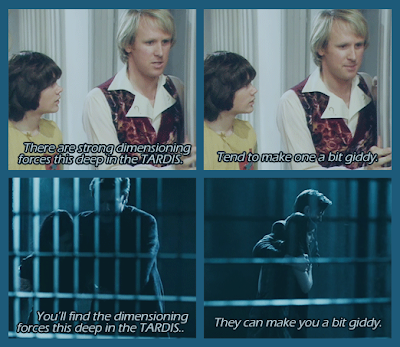Series 19, Story 1 (Overall Series Story #117) | Previous - Next | Index
 |
| Captured from the wonderfully named http://goodandbeautifulperi.tumblr.com |
It was the image above that triggered the desire to revisit "Castrovalva" after watching "The Name of the Doctor," and I'm glad I did. It's a great first episode for a new Doctor. Peter Davison is given nearly a full two episodes in the TARDIS to divest himself of the Tom Baker trappings, a process in which he unwinds the famous long scarf, tears up his waistcoat for scraps, and takes off his shoes (all this to leave a trail from the Console Room to the Zero Room deep within the TARDIS) before finally finding a full-length mirror and his cricket gear. Davison also gets to channel some of the past Doctors by jumbling up his companions' names with those from past incarnations and reverting to Hartnell, and Troughton-isms to show how the regeneration process is addling him.
 |
| The rosy colored, and scented, Zero Room. Subsequently destroyed. |
Another motif picked up by Moffat for Series 7 was the use of the TARDIS's cloister bells to signal imminent danger. Although, when used in 7, the threat is a little less imminent. Similar to the foghorn that added a sense of impending doom to "Horror of Fang Rock," the cloister bells here help create a sense of tension while Five and the companions wind there way through the TARDIS's corridors between the Console Room and the ill-fated Zero Room, which would be part of the 25% of the TARDIS's internal architecture jettisoned to provide the fuel to escape the hydrogen in-rush. (Here again, the production team seems to be in the process of stripping down in order to re-tool.)
The contingency trap2 is the one that provides the setting for the latter half of the story, and it's reasonably well-executed, both in terms of nearly being effective in it's deployment, but from the viewer's perspective as we watch a low-budget show try to do some complicated things with clever camerawork and some quick-and-dirty digital manipulation. The sense that peaceful Castrovalva is all wrong somehow is skillfully accomplished. Even the Master's disguise, to the credit of Anthony Ainley as much or more than the age make-up, works. Even though a viewer with the slightest bit of savvy knows that the guy in age make-up in an episode where we've already seen the Master is going to end up being the Master, Ainley alters his mannerisms and speech so convincingly that, even half-expecting the Master to be in disguise somewhere, it's not immediately clear he's the Portreeve.
"Castrovalva" is also one the young philosopher can chew on. It presents a constructed world where the individuals within it are autonomous agents, but they so weaved in to the world they've been created a part of, that they can't perceive its paradoxical nature. They call to mind Plato's men in the cave, mistaking shadows for the full reality. The Doctor helps them see the problems inherent with their world, but still they struggle with the perception versus what they learn must be true. We are pulling for Shardovan and can understand how difficult it must be for him when he responds to the Doctor's query about whether he can yet see the anomalous nature of his world by saying, "With my eyes, no, but in my philosophy..." Our eyes can deceive us, but if we pursue truth with skepticism, inquisitiveness, an adherence to logic, and a willingness to change our minds when confronted with evidence, then we can gain a better understanding of the world. This, ultimately, is one of the greatest lessons Doctor Who can teach us and one of the reasons I'm so glad my kids are starting to enjoy it as much as I did when I was young -- and still do, of course. Inasmuch as the Doctor is an aspirational target, as a parent I hope they learn to see the value of the qualities we can identify that best define the Doctor, and define the Doctor at his best; namely, the explorer's inquisitiveness, love of knowledge, commitment to logic, open-mindedness, loyalty to friends, compassion towards antagonists, and a genuine desire to make the world (whatever world it might be) more just.
 |
| Tegan didn't exactly stick the landing. Image via lottecinema.org |
1. The Fifth Doctor seems to be drawn to big explosions, particularly the Big Bang. He'll nearly ride the ship that it turns out cause the Big Bang to is terminus. And, of course, he loses Adric in the explosion that ended the age of the dinosaurs in "Earthshock."↩
2. The Master must have figured the Doctor would survive his fall at the end of "Logopolis" by regenerating, so really, his hydrogen in-rush trap is the first contingency, or the second leg of a longer trap, to which Castrovalva might more properly be called "Phase 3." One wonders if there was another trap laying in wait that the Master just didn't get to spring due to being caught up in Castrovalva himself?↩